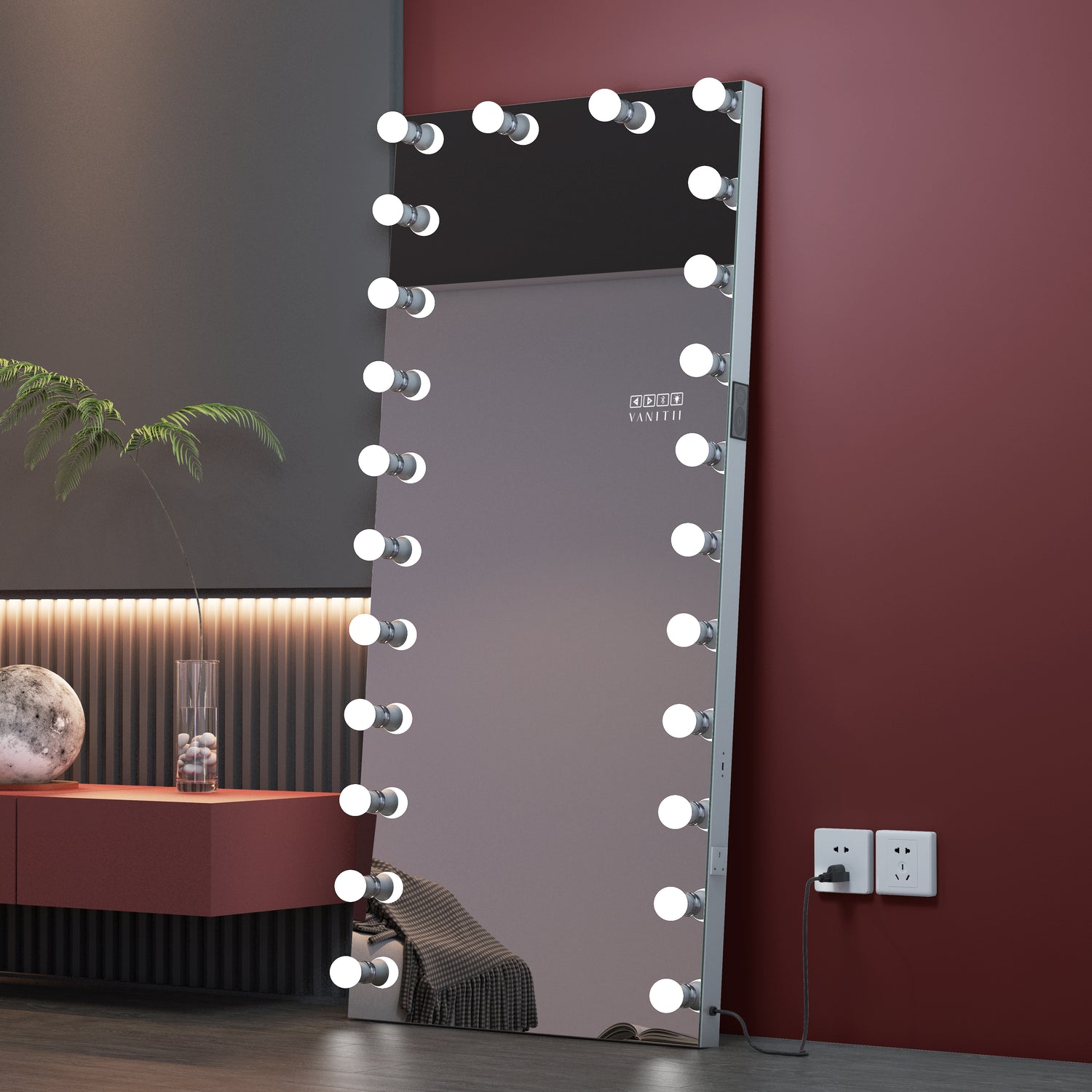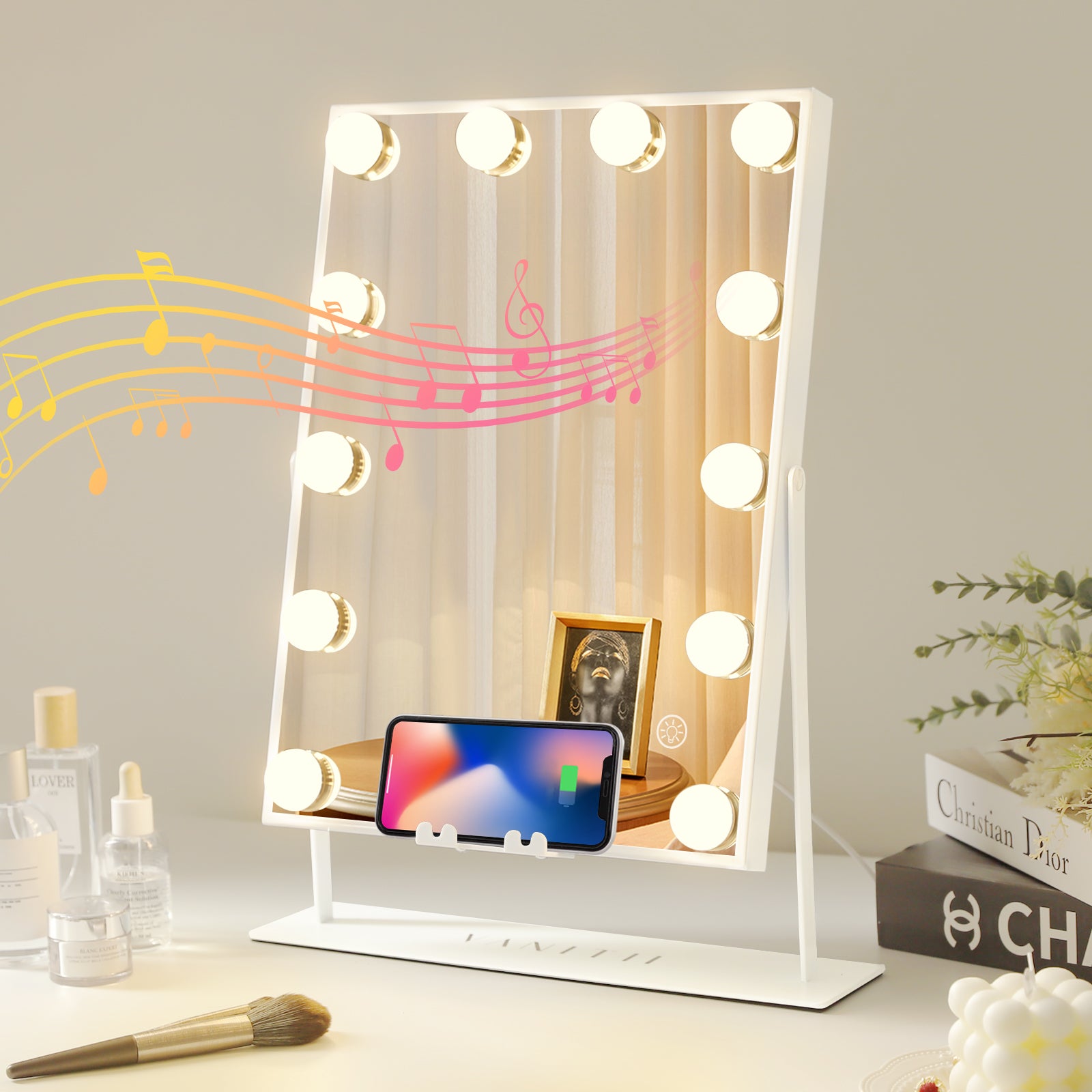The lighting illuminating your face impacts makeup results significantly - whether natural sunlight or artificial bulbs. Their differing hues can either make cheekbones radiate or imperfections emerge. Before investing in elaborate vanities, understand how lighting interacts with cosmetics. This blog will compare warm, cool, and natural options based on goals from precision correcting to selfie flattery. Then guide situational recommendations between lighting for flawless crunch time visibility versus relaxed weekend ambiance to help discover your optimal glow.

What Is Light Temperature?
Light temperature refers to the appearance of lighting, not the actual heat. It's measured on the Kelvin (K) scale. Lower Kelvin numbers around 2700-3000K emit a warmer, yellowish glow. The higher 4000-5000K range appears sharp blue in tone.
Sunlight spans the full-color spectrum and changes through the day. Manufactured bulbs target set benefits by limiting wavelengths.
Natural light shifts over time. At noon around 5000-5500K, it evenly balances surfaces. Warm 2700-3000K lighting makes a cozy evening glow but can hide makeup flaws. Cool 4000-5000K matches daylight, showing detail accurately but can seem harsh.
How Lighting Impacts Makeup on Skin
Light bounces off objects like skin and makeup, allowing our eyes to see color. Different wavelengths of light interact uniquely with pigments.
Textured facial skin scatters light rays in many directions. This diffusion allows makeup particles to adhere properly. Without adequate lighting, the full-color effects get distorted. Carefully controlled lighting is key for makeup to look its best.
To rate accuracy, bulbs get a Color Rendering Index (CRI). This scale from 1-100 compares to ideal natural light conditions (100). Makeup artists recommend CRI 95+. Lower CRI lighting can skew colors - making skin appear orangey unexpectedly!
Additionally, light temperature impacts color. Warmer 3000K glows flatter and soften but can hide flaws. Cooler 5000K lighting shows more detail but may seem harsh by overworking red areas. Balancing warmth and coolness is ideal for optimal makeup visibility.
The Power of Natural Lighting
The Natural Lighting mode in vanity LEDs mimics daylight conditions ideal for makeup application. Pigments are designed based on noon sunlight specifically. However, relying solely on inconsistent natural window light has drawbacks. The Natural mode helps maximize daylight benefits when actual sun access falls short.
1. Benefits of Natural Sunlight
The Natural Lighting mode in vanity LEDs helps makeup appear more natural by mimicking ideal daylight conditions that pigments are designed for. This mode creates a balanced and flexible setting allowing accurate evaluation of application and blending. It can match the shades and intensity of sunlight throughout the day. Using the mode reduces reliance on inconsistent natural window light alone.
2. Challenges with Natural Reliance
While genuine sunlight offers ideal qualities, using just windows introduces limitations like insufficient brightness during early/late hours. The Natural mode helps overcome this, but isn't suited for makeup requiring dramatic or colored lighting. Also, factors like outdoor weather and indoor bulb temperature can still interact to distort intended effects. Properly adjusting between cool and warm environment lighting along with the Natural mode settings takes consideration but allows flawless application. Relying completely on one or the other falls short. Combining both balanced best maximizes ideal lighting benefits.
Warm White Lighting and Its Impact on Makeup
Warm white lighting merits evaluation for makeup routines, beyond tricky natural sunlight reliance. The coveted cozy ambiance mimics evenings by candlelight or fireplaces. But how does this warmer palette impact color evaluation? Pros and cons emerge.
1. Makeup Effects of Warm Light
By omitting cool blue/green wavelengths, bulbs under 3500K reduce color rendering integrity. Darker makeup pigments skew noticeably - contours blend together, and vibrancy fades. Warm lighting essentially "warms" everything in its glow. While selfie-flattering, assessing intricate details or foundation matching grows challenging.
2. Potential Benefits
However, warm lighting still offers redeeming perks explaining its popularity like:
- Promotes relaxation and sleep when used during evening wind-down rituals through melatonin stimulation
- Creates a welcoming comforting environment for leisurely makeup application or removing products after a long day
- Instantly adds visual interest for video backdrops and selfies
- Smaller vanities suit smaller spaces like dorms where multi-purpose use remains essential
Therein lies the tradeoff between enjoyable ambiance and clinical color confidence. Evaluate personal priorities.
Cool White Lighting: A Professional's Choice?
Does using the Cool Lighting mode in vanity LEDs provide an ideal color evaluation for makeup application compared to warm white bulbs? Potentially - it closely matches natural daylight. But possible drawbacks exist with extended blue light exposure.
1. Precision Performance
Many professionals utilize bright, clinical Cool Lighting when assessing intricate details like microbladed eyebrows. The revealing cool tones best illuminate subtle complexion textures and flawless blending precision compared to dimmer settings. However, amplifying every skin issue risks self-esteem impacts over time. Once perfecting techniques, test creations under alternate lighting as well.
2. Potential Harshness
While effectively encouraging productivity focus, excessive blue light from Cool mode LEDs can also feel sterile and harsh long-term. Heavy wavelengths risk eye fatigue and headaches with prolonged use. Additionally, clinical tones sometimes wash out certain skin complexions creating a flat effect. Try supplementing nearby ambient warmth for balance while monitoring usage and taking regular breaks from the intense cool lighting exposure.
Utilizing Various Lighting for Different Makeup Needs
Given the pros, cons, and situational tradeoffs discussed so far, determining universally ideal lighting options for makeup feels unattainable. However, assessing your routines and needs helps indicate suitable fixtures that provide glow in individual contexts. Consider this breakdown:
1. Daily Application Station
Do you require flawlessly blended handiwork with clearly defined edges, precision, and color accuracy daily preparing for hectic work schedules or simply soothing music accompanying leisurely weekends?
If demanding reliable evaluation under crunch time constraints, opt for consistent cool white brightness around 5000K+ enhanced through sizable mirrors ensuring catching every stroke and streak. Add small warm lights nearby for quick shifts in ambiance.
More relaxed? Splurge on smart bulbs with adjustable warmth capabilities or cozier vanities with smaller mirror sizes and surfaces to apply less makeup but soak in peaceful spaces.
2. Photography & Video Capture
Hoping to build that influencer audience through well-lit makeup tutorials and showcasing dramatic looks? Ensure lighting flatters rather than accentuates textural issues.
Consider incorporating classic ring lights emitting diffused illumination around facial curves. Pair with slightly warmer room lighting like 4000-4500K white ambiance bulbs that balance evaluating finishes under bright visibility with photography-friendly tones.
3. Special Event Makeup Station
Hosting lively girlfriend gatherings to prepare for big nights out together? Avoid clinical environments zapping fun energy. Bright enough mirrored stations provide sufficient seeing but focus more on convenient organization keeping ample tools easily accessible to share. Prioritize warmth dimmability through smart features.
How to Choose the Right Lighting for Your Vanity
Now that we've covered primary lighting options and situational usages, how does one select the ideal personal match? Consider these factors:
- Lighting Purpose: Assess your routine. Do you need bright clinical visibility for weekday rush perfection or a relaxed weekend ambiance? This determines essential brightness and warmth capabilities.
- Room Conditions: Lacking windows? Incorporate artificial daylight bulbs. Bedrooms suit cozy tones while open offices may demand cooler sharpness for alertness.
- Skin Tone & Makeup Palette: Find lighting complementing your natural and cosmetic color tones. Identify problem areas lacking dimension too.
- Adjustability & Testing: Avoid labels. Test applications under alternate bulbs first. Portable supplemental lighting also checks real-life conditions. Seek adjustable installations allowing customization tweaks over time for ideal balance discovery.
The right glow awaits by prioritizing personal conditions and needs first through hands-on customization.
Selecting Vanity Lighting That Brings Out Your Best Self
Selecting perfect vanity lighting ultimately requires experimenting with different Kelvin temperatures while applying your signature makeup looks. But now that you know the key characteristics between natural, warm, and cool white sources, hopefully, feel more empowered to narrow options suitable for flaw-facing your aesthetic. The ideal illumination for enhancing your best self awaits your discovery!




Leave a comment
This site is protected by hCaptcha and the hCaptcha Privacy Policy and Terms of Service apply.